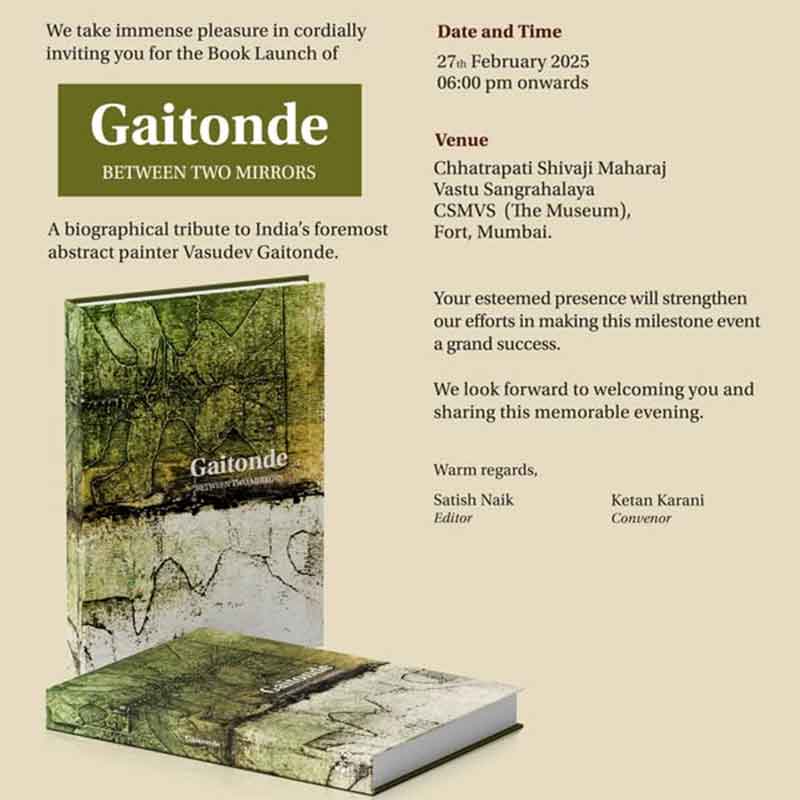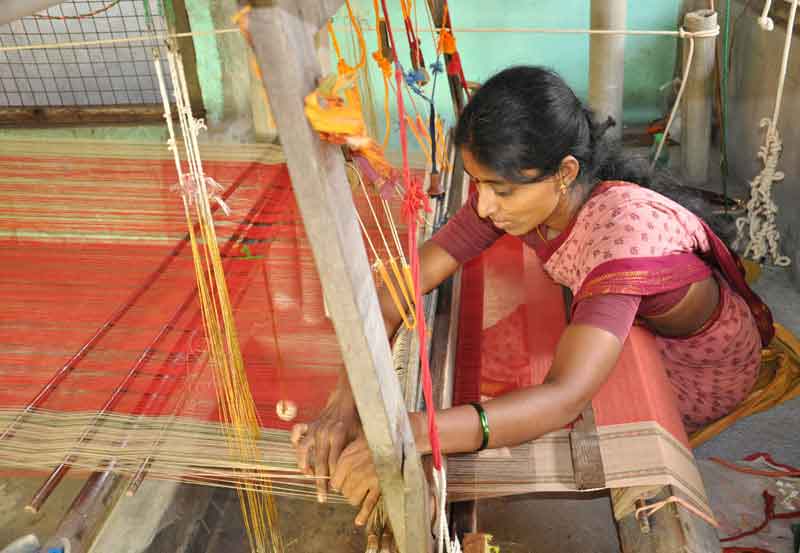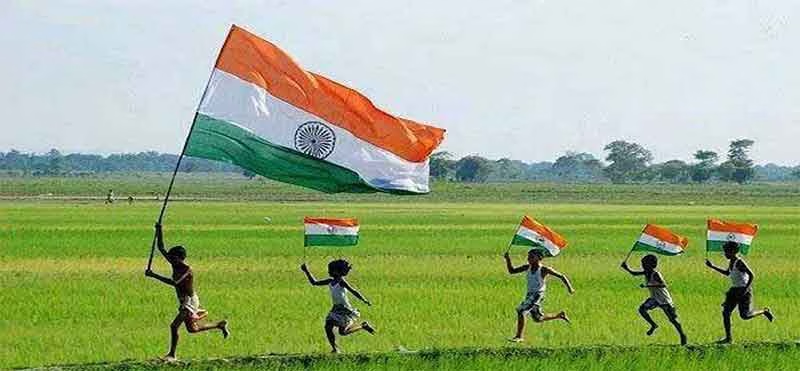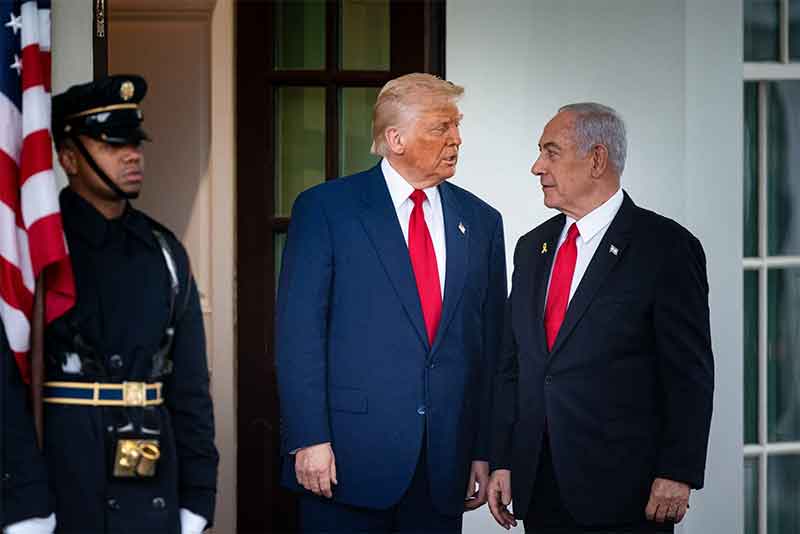Born – 17 September, 1915; Pandharpur, Maharashtra, India
Died – 9 June, London, 2011, England
9Th June 2024 was the Date to Remember and recall the Contributions of Maqbool Fida Husain, the world renowned Indian Artist and the Painter who drew Narrative Paintings in Cubist style and Form and who has been recognized as Picasso of India. His Paintings covering the picturization of India’s Creative Art from Prehistory – Ramayana, Mahabharata to Modern History covering British Era, Mahatma Gandhi, Mother Teresa , Pandit Jawaharlal Nehru to Ram Manohar Lohia is a Unique by any Standard. It is misfortune that such Artist had to go into Exile in 2006 till his Death in 2011, to escape from the death threats from right wing Indian Groups.
Birth of Progressive Artist Group (PAG)
M.F. Husain emerged as a well known Painter and one of the founders of “The Progressive Artists’ Group (PAG), of Modern Artists mainly based in Bombay and was formed in 1947. The formation of such Group was inspired by Progressive Writers’ movement which was started in Indian literature by the Marxist novelists and poets in 1930’s. The intention of the group was to push forward the integration of Age Old Indian Art History dating back to khajuraho and Ranging from Paintings, sculptures and photographs and synthesize it with modern 20th Century European and American Art with their Revolutionary Progress through Post impressionism, Cubism, Surrealism,nd Expressionism etc..
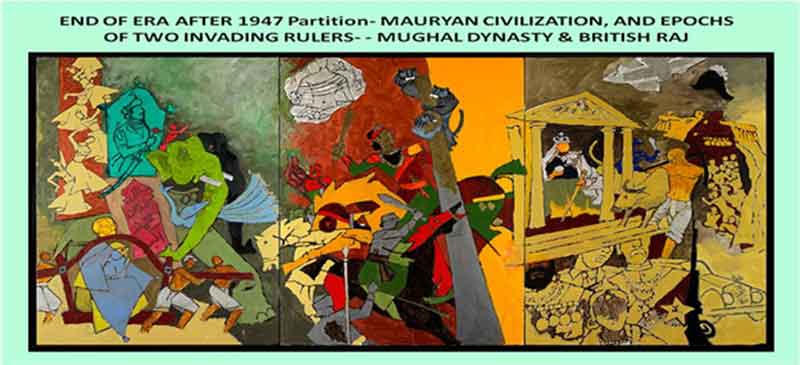
Committed to Freedom of expression the group consisting of Ara, Raza, Souza, and Bakre and M.F. Husain and others carried forward the same for some time. The Group Members abandoned traditional, academic style painting and worked towards liberating the Art entangled in conservative Art Movement. The Group was formed after the Partition of India and Pakistan and it provided the impetus to override the injuries, Bloodshed and loss of Life inflicted by religious rioting and death of tens of thousands of people displaced by the new borders.
Cry for ‘Union with Mother
M.F. Hussain’ s role as a painter cannot be understood without understanding the most painful impact and experience in his childhood, at his age of one and half years when Maqbool ‘s mother passed away in 1917. After remarriage of his father the child Makbool was brought up by second wife of his father who migrated to Indore after the marriage. It is not an accident that the in M.F. Husain’s life loss of mother had a long lasting impact on his psychic life and its expressions are discernible in every act of his Articulation in his Music, Films and Paintings. The instinctual Articulations found sublimated and rebellious expressions in all his creations. His statement, “ I lost my mother when I was one-and-a-half years old. All that love and affection which a child needs, that I missed. So, I am a rebel” speaks volumes about his becoming a rebellious Painter who broke all Norms and restrictions. It is clear that – “A New Born Child falling and held Gently by Falling Leaf expresses his alienation and psychic fear. Child falling imagery in dreams and phantasies is Biblical Symbol and Myth and represents ‘Loss of Mother”. We come across such Myth about Saint Kabir also, who was found by couple walking down the shores of a lake or reservoir and was brought up. Also “Mother Teresa- Goddess of Peace” with Unknown New Born Baby on her Thigh or Lap illustrates his psychic cry and drive for ‘Union with Mother.
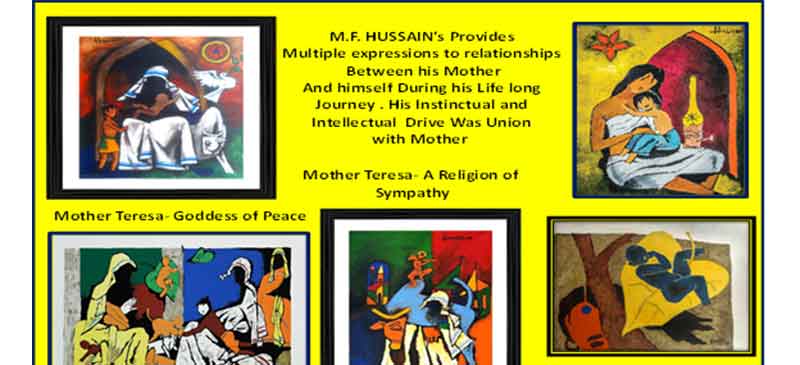
His Paintings of Mother like Females without Facial Incarnations indicates that M.F. Hussain searched for his Mother in every ‘Woman’s Face’. In his life, Husain had done many series and one of these was venerated figure of Mother Teresa which first appeared in the art of Maqbool Fida Husain in 1980. Since then he dedicated numerous canvases to the subject of Mother.
For illustration Mother Teresa stands out as testimony to the profound impact the saint as Mother had on the artist’s life and work. While often Mother depicted as a faceless entity, these paintings explore notions not only of the Mother Teresa herself, but of motherhood in general, from the biblical Virgin Mary to Husain’s own mother.
His ‘Faceless” ‘Mother Teresa’ paintings also is depicts as a faceless but identifiable woman / female holding on to her lap a weak and vulnerable, baby or a child discovered on a street and held and holding a discovered baby or a street child.
The title ‘A New Born Child Held Gently By a Fallen Leaf,’ the Paintings of Mother Teresa, the Child images forgo the depiction of Female Face. His lifelong search for Mother is expressed in Multiple forms. M.F. Husain himself says, “As I do not recall my mother’s visage, most of my female figures have no face details.” Also since he was born in a Muslim Family with Females Faces are indistinctively visible and his suppressed yearning for a motherly figure that left him permanently bereft. Hence what he depicts in all these five Portraits are the developing relationships between himself as Child and his mother whose face remains Unidentified. In the Five Images M.F. HUSSAIN’s Provides Multiple expressions to relationships Between his Mother and himself During his Life long Journey . His Instinctual and Intellectual Drives worked towards establishing Union with Mother in most Innocent Forms. Child relationship depiction of Mother in Portraits are vague on Canvas. His usage of colors was brilliant and symbolic and the expressive Painting surfaces provide poetic expressions. All his sexual and instinctual Drives find sublimated expressions in his paintings, Musical and few Hindi Films as well
HORSE- HUSSAIN’S MOST FAVORITE PAINTING SUBJECT
Famous Quote by PABLO PICASSO will provide significance of Painting Horses in the life of Painters., ‘“If I paint a wild horse, you might not see the horse… but surely you will see the wildness!” ― Pablo Picasso. It is also not wonder that Picasso advised all upcoming Painters to draw horse. M.F. Husain’s Fascination to draw Horses is well known.
Horses were Husain’s obsession and they were represented as majestic animals, representing courage, freedom, gallantry, triumph and most importantly aggressive or destructive surges in his Art Work .He painted them to allude to inner contemplation and as a Universal, pervasive and omnipresent motif. Horses appeared in Husain’s \Paintings since 1950s and he developed his own style while painting them. His obsession with horses was since childhood and he reminisced them through exploration of religions, countries, and civilization.
In paintings, the horses are not steady rather they are depicted running against each other towards the finishing line and fighting in the battle. They unfold Husain’s expertise in sense of movements through lines. He manifested multiple concepts of his horse paintings. Hussain’s masterful brushstroke transformed the horses into dynamic, pulsating, and awe-inspiring creatures.
Artistic Imagination has Organic relationship with Dreaming and Phantasization. Michel Foucault states that, “Every act of imagination points implicitly to the dream… the dream is the first condition of its possibility.”
I have prepared a Collage of few of M.F. Husain’s Painting to highlight what horses represent multiple modes and forms of instinctual expressions in the state of dreaming and phantasization.
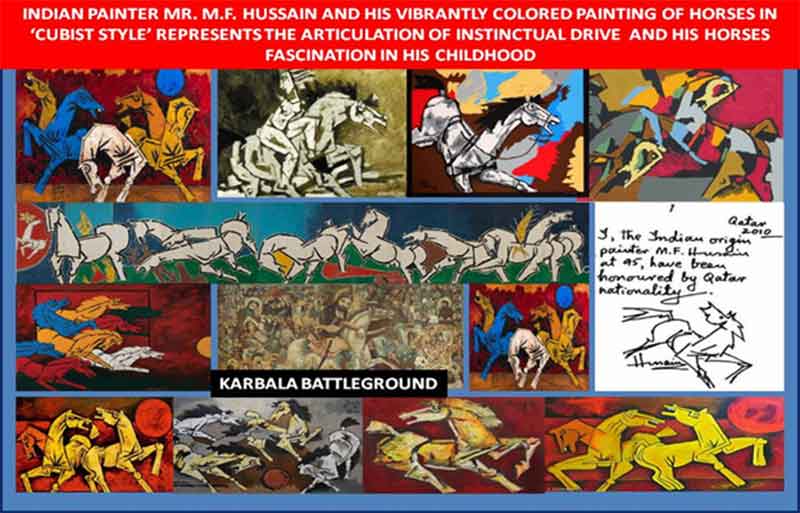
Horses, with the beauty of a woman and the valor of a man.
Start shooting past me like arrows, swift from a bow.
For long years they have been galloping like this,
And I have watched them all along.
Suddenly, a black horse noticed me.
He paused, turned back and said to me.
“Go forth and see the world.”
(Rashda Siddiqui, M F Husain - In Conversation with Husain Paintings, 2001)
M.F. Husain had tremendous fascination for Horses since his childhood and painted innumerable Paintings depicting Horses in variety of situations and events. These majestic animals, represented courage, freedom, dauntlessness, gallantry, and triumph but more importantly the human sexual and instinctual drives as well. He painted them to articulate his suppressed and covered mental thought processes, inner contemplation and as a Universal, pervasive Motives. ..F. M Hussain provided variety of forms to instinctual articulations- in painting of horses, from Fighters to most destructive forces at different events and situations.
Horses appeared in Hussain’s oeuvre in the 1950s when he had crossed his thirties. His obsession with horses was since childhood in Pandharpur and Indore and he reminisced them through exploration of Past, Religions, countries, and civilization. We see the paintings with horses head turned back, their flying manes, hooves and tales! His obsession with Horses is noticeable since his childhood when he used to draw flying horses in the Margins of his notebook. It is not coincidence that Picasso would often instruct the New coming painters to treat horse as basics of paintings. This is since they represent conglomerate of thundering instincts in the ‘unconscious’ and can express themselves in multiple states of emotions in the paintings.
PABLO PICASSO & M.F. HUSAIN’S ANTI- WAR PAINTING
M.F. Husain witnessed and participated at the anniversary of the battle of Karbala, in which the Islamic prophet’s grandson was killed. Muharram, carrying the effigy of horses. The Childhood, memories were stunningly re awakened during two occasions, one his visit to Iraq in1965 and First Indo Pak war. Closer look at M.F. Hussain’s journey from childhood to Adulthood appears to be Articulation of his Unconscious in the Form of Dream Images and Phantasies. Distortions and Condensations are discernible. Though he did not have any interaction with Psychoanalysis directly the Images are inherent drive for expressions of his ‘Unconscious” the store of images. His close association with modern paintings enabled him to work out images.
He visited Iraq in 1965 and stumbled upon the battleground of Karbala and felt a mystic connection. After this visit and the experiences of the first Indo-Pak war (1965) his horses became “riderless and mesmerized by arrows as examined by Daniel Herwitz”.
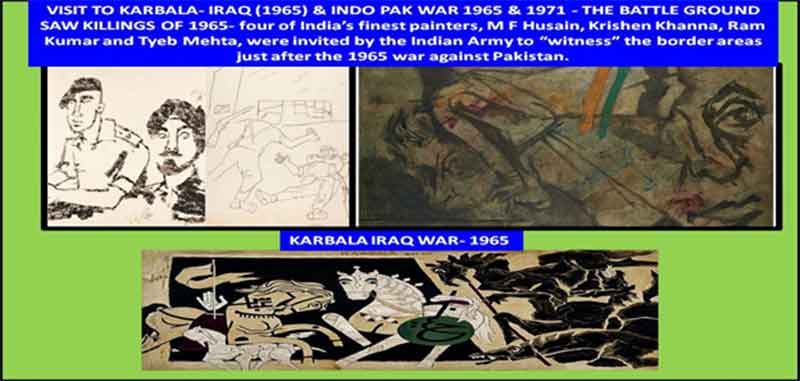
The Violence, , Killings and destruction became the expression of dance of Uncontrollable Death instinct!. Horse has been used by M.F. Hussain as the symbolic representation of Fight and as Death Instinct as well. In 1972, troubled by the War India fought with Pakistan he made the appeal for peace by merging- with collagen the three protagonists of war Indian Prime Minister Indira Gandhi, leader of West Pakistan Zulfikar Ali Bhutto, and Sheikh Mujibur Rahman, Awami League leader. He also depicts the devastation of the war and the strands of saffron and green in a corner.
Here Pablo Picasso who owes methodological roots in Psychoanalysis could express himself in imagery into three dimensional ‘Cubist forms’, to develop in synthetic ‘Cubist’ forms. In paintings, the horses are not steady rather they are depicted running against each other towards the finishing line and fighting in the battle. They unfold Hussain’s expertise in sense of movements through lines.
Here we are reminded of Pablo Picasso’s magnificent Guernica, painting of the Spanish village s destroyed and ravaged during the Spanish Civil War, remains the most enduring image of the conflict that lasted for decades. In this most celebrated Painting condemning the War. German Aircrafts on request from ‘Patriotic Nationalist heavily bombed the city of Guernica on April 26. It resulted into annihilation and destruction of City and wounded and killed one third of population. The devastation made sharp impact on Picasso’s mind and heart and propelled him to create the enormous historical Painting. The crying horse occupies the Centre of the Painting. Horse represented the Patriotic Nationalist forces and the Bull represented the Mass of people getting crushed and destroyed. The Horse stumbles against the Rider crushing the rider under its own feet.
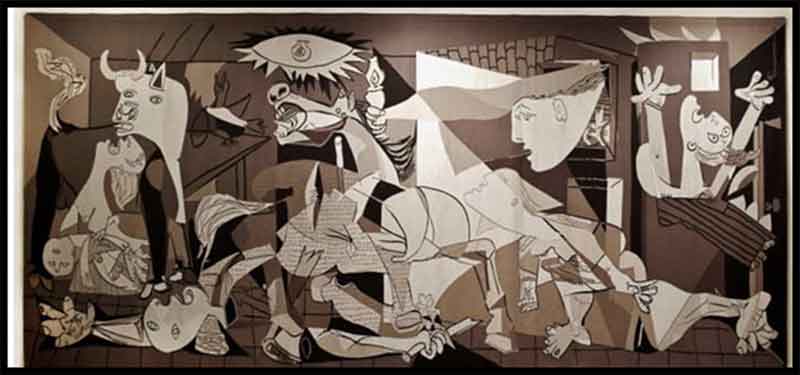
It is the dreams and phantasies which are considered as the starting point of the imagination. From Renaissance to Romantics and Surrealists since the Artistes, painters have expressed and articulated the Art Work as sublimation of their Dreams sprouting from their Unconscious and Preconscious. Horses have long been considered as symbols of Power, strength and even aggressive destructive instinctual expressions and representations in Dream.
Making of Maqbool Fida Husain as Young Painter.
M.F. Husain portrays his Childhood.-“My Childhood”
Indian artist Maqboul Fida Hussain was born on the 17th of September 1915, in Pandharpur in Maharashtra. M. F. Husain lost his mother when he was a young boy. Subsequently his paternal grandmother looked after him. Later, he was sent to live with his maternal grandfather at Siddhpur in Gujarat. Here Husain learnt to read Urdu and became fascinated with the geometric forms of Kufic Calligraphy. This sparked his interest in drawing.
His first endeavor for Picturization of Male and Female Child at the Age of Twenty in 1937, Husain moved to Bombay against the wishes of his father and joined a cinema poster painting workshop. “with a meager start of six annas a day”. By 1941, Husain got married and had to continue to get steady income. It proved to be a great breakthrough in his life and propelled his emergence as a Painter! He found work as a designer/painter at a company that made children’s toys and furniture. M.F. HUSSAIN BRINGS OUT HIS CHILDHOOD MEMORIES IN THESE PAINTINGS
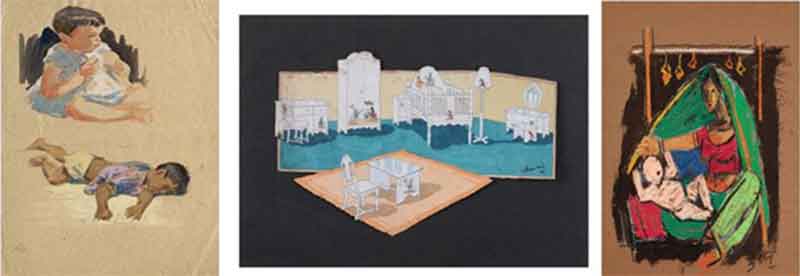
SURGE OF UNCONSCIOUS CHILDHOOD MEMORIES. OF PANDHARPUR
His Pandharpur visit in 1995 should be regarded as one of the most emotional moment in life of M.F. Hussain. He was very enthusiastically greeted by the people gathered over and around temple and the river banks. It was his visit to his Birth Place Pandharpur of Vithal and Rakhumai, the place regarded as Epitome of Secularism of Mass of downtrodden and laboring population in Maharashtra. Pandharpur remains the founding base station of Warkari Panth where Religious and Caste Divisions get dissolved in the cultural movement of pilgrimage for the Warkari’s the followers of great Marathi Saint Tukaram. M.F. Husain profusely wept and cried by bowing down his Head before Pandurang- Vithal and he drew and offered a Painting before the Audiance . The Painting- Portrait of Pandurang is as pasted below. It is It is certain that while bowing down, he must have remembered his Mother which awakened desire to reclaim her ‘Pad-Sparsh’. The Unconscious Imagery well grounded in his Psyche Surged to create this Painting of the VITHAAL IDOLin a single minute. The ‘Pujari’ ( ), Sidharth Dhawle, who welcomed him at the Venue speaks in thrilling words about the Panduram’s painting and female dancing before Pandurang while Playing the Veena Instrument ! It appears that he discovered the creative Surge from the unconscious and Psychic experience of ‘Self Discovery” and ‘self analysis’ in the painting drawn.

M.F. Hussain’s story of Ramayana drawn at Moti Bhavan- Indore.
Those who criticize M.F. Hussain for ‘Anti Hindu’ stance must visit Indore’s Moti Bhavan to see his paintings on Ramayana. The storey of his Paintings tryst on Ramayana goes back to his encounter with Dr. Ram Manohar Lohia. M.F. Hussain says that as a Boy and Child- Young painter in Indore he says, “it was Dr Ram Manohar Lohia who showed the path that led to Valmiki and Tulsidas.”When M.F. Hussain saw Dr. Lohia in “clad in khadi and sporting badges on their jackets, grabs a pen from Badrivishal’s pen-stand, captures the scene for posterity. His pen sketches Dr Lohia’s unruly hair, moves down to his half-closed mischievous eyes, then nose and stops at his lips”. Dr. Lohia impressed by the sketch, he breaks into a smile and hugs the boy very tight. M.F. Hussai says that “It’s an embrace that will last for many a years”.
One evening, the Indore boy takes him to Karim Hotel in Delhi as Lohiaji loves Mughlai food, sheermaals etc. Dr. Lohia remembered Portrait drawn by this boy of Jawaharlal Nehru which the boy had sketched at the PM’s residence. Lohia asked him, “What made you think of drawing a portrait of Nehru? One portrait of his which I did like was the one published in the Illustrated Weekly because in it he seemed to be drowning, already neck deep in water”.
M.F. Hussain, the Boy replied, “Lohiaji”, the boy replied smiling, “That is the interesting complexity of modern art. Here the viewer has the right to interpret it the way he likes while a still photograph offers no such latitude. From that point of view, modern art is not elitist but democratic. Here you may depict a royal personality, use tense lines proclaiming individuality and a splash of colours suggesting self-esteem.”
Lohia patted M.F. Hussain, the boy, on his back as if in compliment and changing the subject he asked him to come out of portraits adorning the drawing rooms of Birla and Tata. Paint the Ramayana. It’s an engrossing eons-old tale of this country. India’s villages are resonant with song and music. Take your paintings to these villages. Behind the closed walls of what are called galleries in cities, people with hands in their pant pockets just stand before your paintings. They are not like people from the villages who, immersed in your colours, will break into song and dance”.
Hussain says, These words of Lohiaji pierced my heart like an arrow, pricked me for years. Soon after his demise, in his memory, with pen and brush, I splashed the walls of Moti Bhavan with nearly 150 scenes from the Ramayana. It took me 10 years. I asked not for a paisa for my labour. It was only for honoring his words to me.
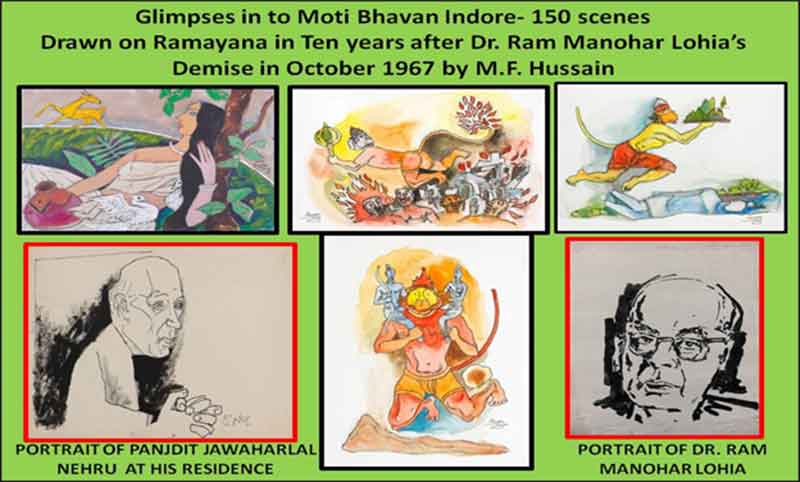
The ‘Sound of Unconscious’ Role of Musical Tool in making of M.F. Husain as Great Painter.
It is noteworthy that in M..F. Husain’s as well as Pablo Picasso’s life Music played very significant Role in transforming them into great painters. In their case Music played role of awakening of their suppressed ‘Unconscious’. Music played the role of important tool through which the crystallized suppressed imagery and memories in psyche are affected and impacted. The Artists and painters equipped with the techniques of using sound, rhythmic musical notes can regress into the Psyche and get access to their past (Nostalgia) emotions and to core of sexual and infantile instincts and facilitate their sublimation and finally transformation into Paintings and Art work. All these elements find an articulation in the natural as well as complex activity of listening, which conveys a tri-dimensional and polyphonic dimension of the world. This is how musical instruments work like Psychoanalytic Verbal Therapeutic interactions. Ludovica Grassi (Italian Psychoanalyst) in his Book (work) ‘The Sound of the Unconscious’ is meant to train psychoanalysts and psychotherapists. Role of Music and instruments provided methodological core to M.F. Husain’s as well as Pablo Picasso’s Painting Works. This concept as Tool provides insights into florescent growth in M.F. Husain’s Status as painter from 1950.
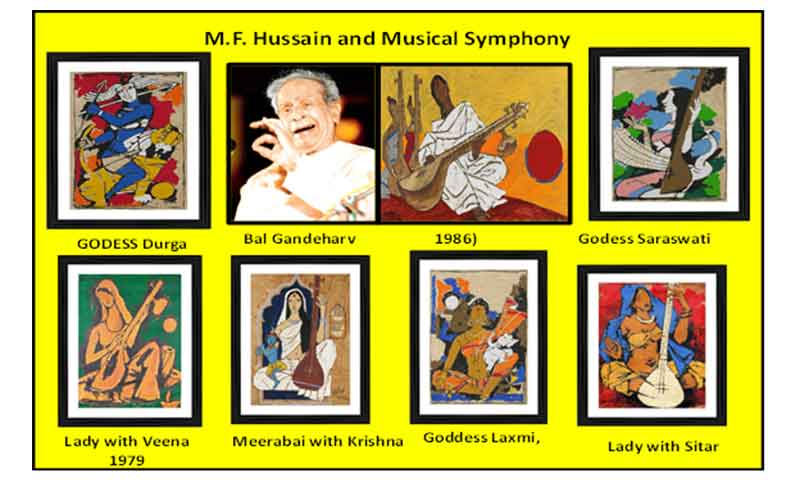
The above Paintings speaks volumes about M.F. Husain ‘character as the Most Secular Muslim who paved the way for the Modern Art to reach into International Arena.
Archetypical Themes in M.F. Husain’s Painting
Another Psychoanalytical dimension in M.F. Husain’s paintings are discernible in several of his paintings after 1950s. Influences of Mathura Sculptures. Representation of iconic deities, Holy Figures of beautiful women, musicians, incorporation of metaphoric human figure, symbols of snakes, various symbols representing archetypal themes of life, love and death rooted in collective unconscious are traceable in M.F. Husain’s paintings. This appears to be the result of the influence of Expressionist Painters Paul Klee and Wassily Kandinsky on M.F. Husain. The painting Fertility and others drawn by M.F. Husain in 1955, blends the Ancient Indian art and Modern art into one.
On the right, a seated male figure faces the viewer, his torso grey with faint accents of deep red and bright yellow. Though his facial features are abstract, his silhouette is defined with broad, dark strokes. The female figure next to him, by contrast, is a beaming, abstract vision of vibrant orange, red, blue and green. The yellow-orange orb glowing within the woman’s torso perhaps best signifies the title “Fertility”. The influence of modern art is evident in Husain’s use of abstract form and fervent application of brisk, intuitive strokes of paint It is not an accident that Nazis irritated by Klee’s paintings labeled his Art as Degenerate Art and punished him and had to spend his life in exile. M.F. Husain also had the same fate.

M.F . Hassan’s Outstanding Painting on Nazism and Adolf Hitler
This Painting acquired most Controversial Status after Makbool Fida Hussan’s exile to Middle East after persecution and life threat to him from the Ultra Right in India. Number of viewers and commentators have failed to decipher the Historical Significance of the painting and number of them have Clubbed it as integral part of his Nude paintings.
It is noteworthy that M.F. HUSSAN has created most of his paintings as bridge between the past and the present. They have become the interpretations of the past. Though his paintings are presented in modern Synthetic Cubist Forms by objective three dimensional visualization of the contents into flat surface. The Nazi Painting stands out as great illustration.

The Painting needs proper Interpretation, representing Four Historically most significant and known Figures who contributed to Human History of the World. The Painting Portrays and depicts Adolf Hitler, Albert Einstein, Karl Marx & Mahatma Gandhi. Hitler as representative of NAZISM stands in contrast to the historical progression and has been shown as Nude with Draconian face and with Swastika mark on his Left side of his Chest and Arm with intention to humiliate him and define his regressive most role. As villain of the History and as unparallel mass murderer holding in his right Hand the Human Skull, the Symbol of devastating destruction of Human Life. Other three in complete contrasts are Humanists and peace lovers are demonstrated as responding to Hitler’s Role by covering his eyes and head with cloth. Mahatma Gandhi covering his Face with shame felt at Nude Hitler, Einstein Holding his Book, on Theory of Relativity and Karl Marx Marx, red faced with Einstein holding ‘Das Capital’, Geetanjali of Ravindranath to project their Historical Role and their historical Contributions and role as representatives of the Mass of People. It is not the Nudity which is crux of the Hitler’ role s drawn to humiliate him but the SWASTIKA on his Human skull drawn on symbolizes his ugliest role as Killer of Human Race in concentration Camps and through all out war. The Painting has other connotations as well.
Subscribe to Our Newsletter
Get the latest CounterCurrents updates delivered straight to your inbox.
Historically Nudity in ancient Indian Art and Renessan period has been used by sculptures, Painters and Artists etc to celebrate the beauty and perfection of the human body. In Renaissance art, and Indian ancient At and Mythology nude figures have been depicted in religious and mythological scenes, often symbolizing purity, fertility, or divinity. There is one more significant thread to this specific Hitler’s Nude Paintings. Makbool Fida Hussain who organically owes origins of Paintings to Renaissance was forced to leave India and exiled to Middle East countries, as response to aggressive stand by Right Winger Indians who showered death threat against him identifies them as worst than Nazis. He states that “Hitler cracked down on artists when he came to power in Germany. And this is precisely what the right wing forces are doing in India. These people are worse than Nazis and should be persecuted. ” We are aware of the Nazi persecution of Artists, destruction of Art Work and burning of works of Marx, Freud and several leftists and liberals after Hitler’s coming to Power. Hitler’s paintings compounds these two trends in different historical epochs:.
There are several commentators who have launched from mildest criticism to severe most one and have asked whether M.F. Hussein would have dared to paint or portray Female bodies. Reply to such criticisms by Badrivishi Pitti, “ Hussain’s women have been imbued with an asceticism and an angularity”. M.f. Husain drew his Inspiration from pre- historical creations of paintings and Sculptures at Khajuraho Temple. In his Film, “Meenaxi: A tale of three Cities was forced to withdraw from Cinemas, since Number of Muslim Organizations severely launched protests against the Song- Kawwali-Noor- Un Ala Noor was termed by them as Blasphemous. On the other hand there is no dearth of Hindu paintings of Female Figures and Sculptures of Khajuraho and Paintings at several Locations. Hence criticisms of M.F. Husain’s Nude Painting fall Flat.
Anil Pundlik Gokhale is an Engineer by profession. As a non regular writer on political literature I have always been attempting to integrate Psychology and Marxism. I have recently published books ‘Condensation And Condescension In Dreams And History: Essay – From Sigmund Freud To E P Thompson’ by Author House London. Psychoanalysis & A- Historical Story of GENGHIS KHAN, Author House- London.

